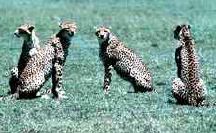Son of Hugo
Globetrotting naturalist
By David Templeton
Hugo Van Lawick is to wildlife cinematographers what Orson Welles is to aspiring actor/directors--though Hugo has yet to shoot a wine commercial. His spectacular '60s-era images of the respected primatologist (and then wife) Jane Goodall working among Africa's chimpanzees are legendary. For 30 years, his shots of wildlife on the plains of the Serengeti have served as a benchmark to those unfearing souls who ache for the chance to put a camera (or a microphone) right in the snarling face of nature.
"I was certainly inspired as a young man by the work of Jane Goodall and Hugo," nods composer/naturalist Douglas Quin, after meeting near his Sonoma home to see Van Lawick's latest cinematic offering, The Leopard Son, a miraculous encapsulation of two dramatic years in the life of a Serengeti leopard cub.
"Amazing!" Quin exclaims as the film comes to an end. "Every shot is a work of art. It's just beautiful." His appreciation is in part informed by his own experiences on the plains of Tanzania, not as a photographer, but as a collector of wildlife sounds. "When you spend days and weeks in these places, you realize just how difficult it is to translate those experiences to film, to tape, to video, whatever the medium is."
Quin's own quest for things that go bump in the night has taken him to Africa, to the Brazilian rain forests, to the North Pole. Later this month he'll depart for the continent of Antarctica, where he will spend six weeks following penguins, seals, and icebergs. His recordings, which are used in a variety of museum and zoo exhibitions around the world, are also the basis of some extraordinary musical compositions, such as the recent Oropendola: Music by and from Birds, an evocative weaving of natural bird song and man-made melody.
At the moment, however, Quin has ears only for Africa.
"The wind is a constant there," he recalls softly. "I was reminded of how much I was always struggling with recording with all the wind at dusk. There was almost always wind out on the plains, rustling in the grasses. There are so many sounds. The sound of baboons encountering a leopard is quite distinct. A lion roar will carry for miles. You hear that roar and no matter where you are, everything stops, looks up, gets a fix on it--as in, 'Where's that?' and 'I don't want to be near that!' Birds. Animals. Everything stops right in its tracks. It's really an amazing sound."
And leopards?
"I was there six months and I only saw two leopards," he shrugs. "One with a kill of a gazelle, up in a tree, sleeping and resting. You really have to look for them. Hyenas are also fairly elusive. I followed one for three hours and then--poof!, it was gone. Baboons, however, are right there in your face."
And they're nasty, too.
"They have teeth you wouldn't believe," he smiles. "I remember putting together dinner the first night I was in Kenya. All of a sudden, one baboon comes and sits about 50 feet away. Just sits, looking at us. Ten or 15 minutes went by, and we were surrounded completely. Then the larger ones would approach, one at a time. One would come, and I'd toss rocks at it to make it back up, and while I was preoccupied with him, another one would come, while a third made the run for the food. They worked in twos and threes and fours, and just played me till I didn't know where I was going. I was just spinning around. In the end I packed up the food and put it in the car, and we ate in the car. Four or five baboons can put together quite a strategy for getting what they want out of you. They have the patience of Job."
Or, one might say, the patience of a wildlife artist, of a Hugo. Or of a Quin.
"There is a lot of waiting around," Quin agrees. "But in that waiting there is a kind of peace and stillness, of being attentive. I think it speaks to that hunter instinct of being alert. Of all senses being primed for experience. It's exciting to be attentive for long periods of time.
"So much of our daily lives is about distractions, and overcoming or masking our hearing and sight. Because we have this to do and that to do, our lives become sort of parsed out into these tasks that don't always involve paying attention. Life conspires, in most situations, to prevent us from having that attentive, sensory stimulation in overdrive.
"What was so beautiful about that film," Quin adds, "was that the richness of every shot was almost overwhelming, and then you realize that years of this guy's life, of that heightened sense of awareness to the world around him, is brought into every single frame. It truly boggles my mind."
This page was designed and created by the Boulevards team.

Douglas Quin explores
Hugo Van Lawick's
newest film
Writer David Templeton takes interesting people to interesting movies in his ongoing quest for the ultimate post-film conversation. This time out, he takes in the sumptuous wild-life epic The Leopard Son with award-winning musician and naturalist Douglas Quin.
Copyright © 1996 Metrosa, Inc.
![[MetroActive Movies]](/gifs/ma-movies.gif)